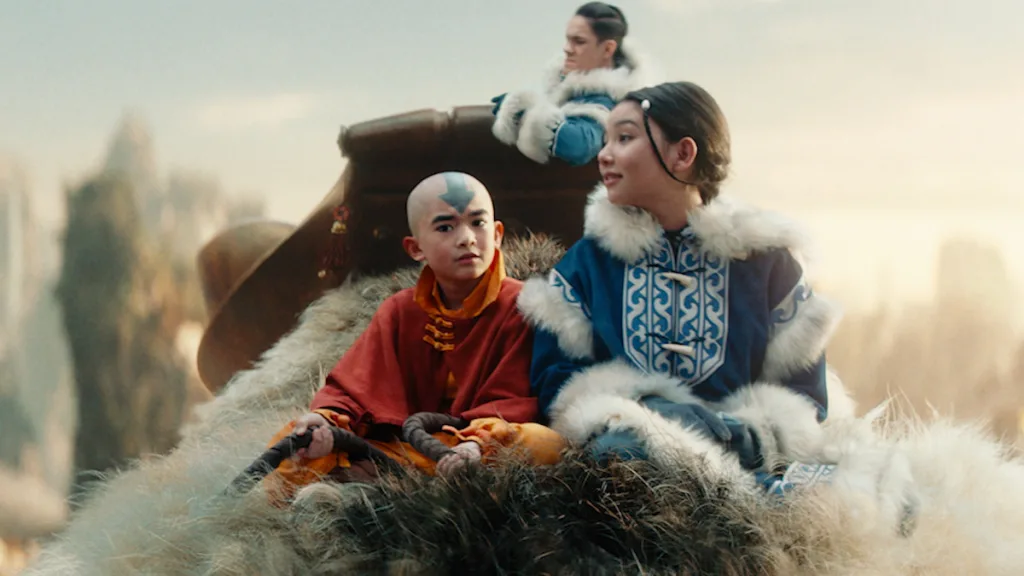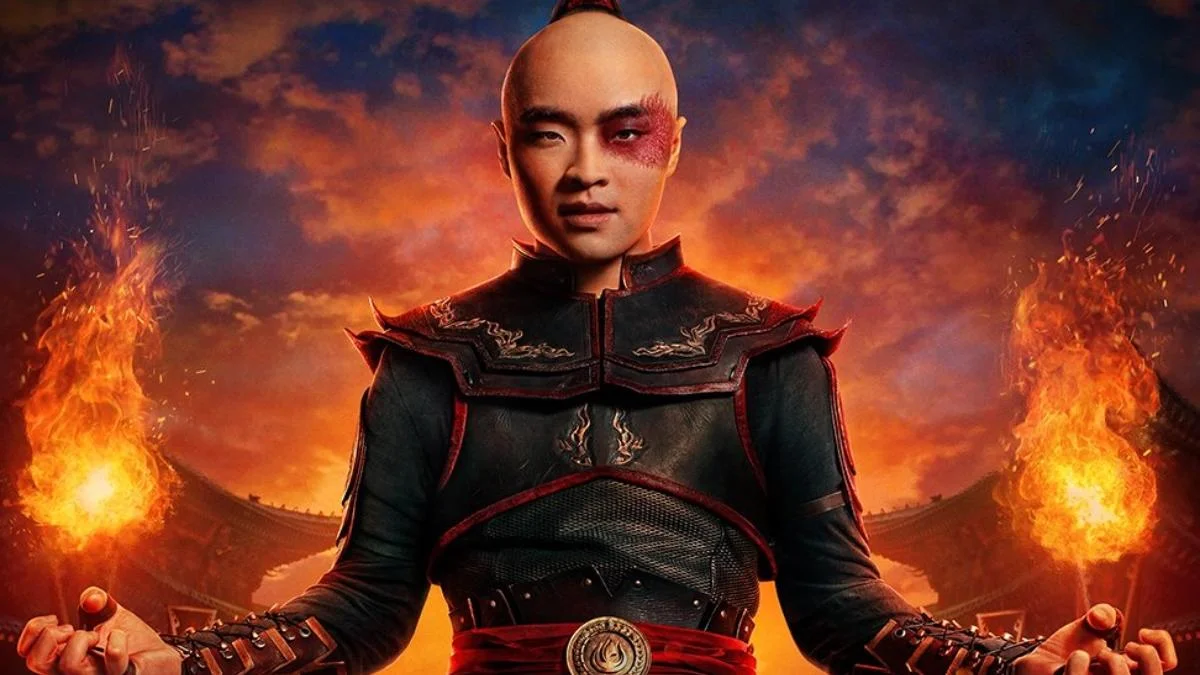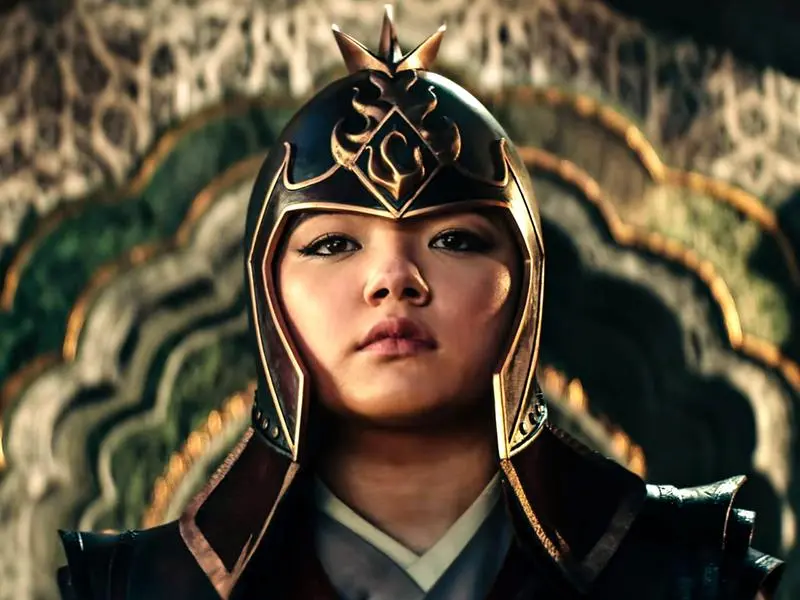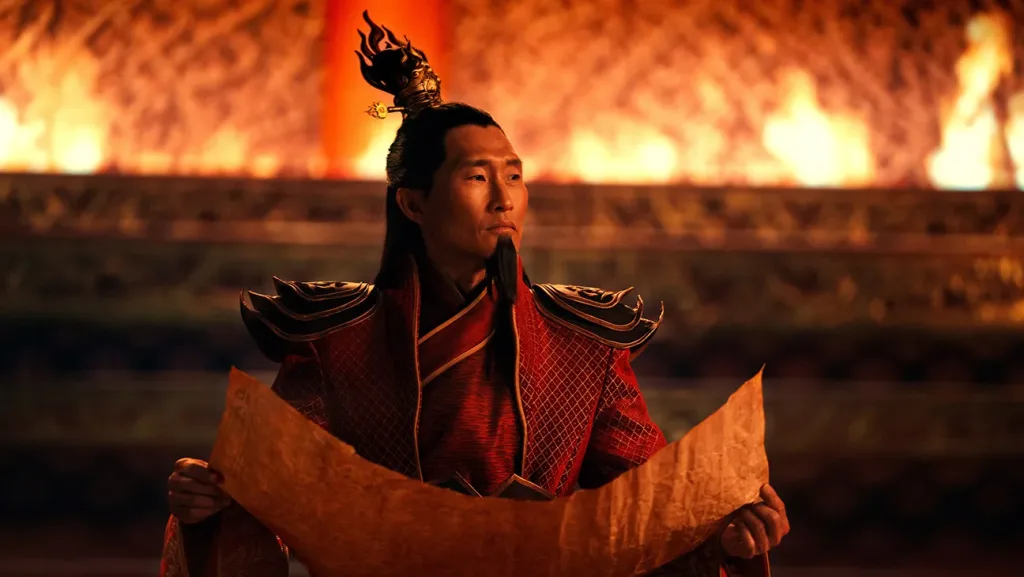Nickelodeon’s animated show Avatar: The Last Airbender (ATLA) has been widely praised across the years, and the announcement a few years back of its live-action remake on Netflix was met with both excitement and skepticism. Having watched all eight episodes of the new show, Sunil Patel, Victor Catano and I discussed what we thought worked… and what fell flat.
Mary: So having been a fan of the animated show and now watched the live action adaptation, what were your overall impressions?
The most striking thing to me right off the bat was the uneven tone. The show’s content has always been pretty dark, being about war and all, but live action made everything feel more violent, and it seems like they purposely leaned into it? Like showing people burning alive? Which made the fact that the main heroes are young kids feel a bit bizarre.
Victor: I had a similar reaction. The show was originally a Nickelodeon animated program aimed at kids and young teens. While it covered mature themes, there was a limit to what Nickelodeon would allow.
But here, in the opening scene, people are getting graphically burned alive. All through the show, the firebenders are torching people. They show in great detail the massacre of the air nomads. It’s a lot! This seems like it’s definitely pushing the edge of PG-13 and would probably not be shown on its network of origin.
And I agree with you about the age of our heroes. In the cartoon, it seems perfectly acceptable that children would be off to save the world. Maybe because it’s adults doing the voice work. But in live action, they all seem so young! And it’s a little disconcerting to see Fire Nation soldiers trying to murder a child!
Sunil: When I first read they were going to show the genocide on the show, I wasn’t quite sure if that was necessary, but while I agree it’s surprisingly graphic and distressing, I don’t necessarily think that’s a bad thing. I like that this version of the show can engage with the horror of war more directly, and I found the choice to begin with the wiping out of the Air Nomads interesting as it puts us in Aang’s perspective and really makes that loss hit home, as well as his guilt for not being able to stop it.

Mary: That’s true. And ATLA certainly isn’t the first live-action thing ostensibly aimed at kids to depict violence. The Hunger Games and Star Wars Episode III: Revenge of the Sith come to mind. The first because it’s got a super violent premise yet is about and aimed at teens / tweens, and the second because it also depicts a genocide (including the deaths of children). But ATLA somehow felt more graphic than both of those, and I think it’s because of some of the visual choices they made. The Hunger Games had much of its violence implied, or at least depicted in a less graphic way. And Revenge of the Sith showed the massacre in montage, which made it feel less visceral yet still tragic.
Victor: What changes from the animated series worked for you? And what didn’t?
Personally I’m glad to see them giving Azula more backstory. In the original show, she comes off as the crazy daughter. Here, she’s shown scheming and plotting and subtly manipulating Ozai.
But because there are only 8 episodes, a lot of the cool smaller characters get rushed. Bounty Hunter June is so cool with her mole thing! And she has a total of 5 minutes of screen time.
Sunil: I agree about Azula! While I wish she’d been more psychotic, I can understand wanting a more nuanced portrayal for this live-action version. But I loved her role as a secret active antagonist for Zuko.
I really enjoyed so much of the clever remixing, like placing Jet at Omashu or doing the Cave of Two Lovers with Sokka and Katara, which I know may seem kind of weird, but I think the show nailed their sibling relationship.
There were also a couple small changes that were so brilliant I couldn’t believe they weren’t part of the original show. Aang stealing Zuko’s notebook to learn about what happened while he was gone adds a lot to his character and deepens his connection to Zuko. And making the 41st regiment that Ozai was planning to sacrifice Zuko’s crew was a stroke of genius.

Victor: I was not as much a fan of that. They mashed about four or five different subplots into the episode, and I don’t think any of them got enough time to breathe.
But I agree on those points about Zuko. The notebook and the 41st make him a lot more sympathetic, especially compared to the animated version screaming about his HONOR every other sentence
Sunil: Not gonna lie, I really missed him not saying HONOR every sentence.
Mary: Totally agree about Zuko and the 41st! And I don’t think he says “honor” once in the live-action show which, thank goodness. Using “honor” as a motivation for Asian characters has become so cliche, it’s borderline racist…
I do feel like they softened him a little too much, though. He was definitely nastier in the cartoon, which made his eventual redemption mean more, and the little moments of goodness that peek through in the first season a bit more surprising.
The live-action show seems so determined to show him as sympathetic from the get-go that he never really feels that villainous.
Sunil: I agree with that. I think it’s a similar thing with Azula, where they want to show the full humanity early. Which is a valid choice and could have its own benefits down the line.

Mary: I do like what they’re doing with Azula. With her, she seems just as nasty, if not nastier, than in the cartoon. More conniving, actually.
Sunil: But in the animated series, it’s UNFATHOMABLE that you would ever like Zuko, let alone think that he could become genuinely good. Here, it seems like a possibility from the start.
Mary: Exactly! Which I feel like makes him lose a bit of his edge.
Another change I like is that they seem to have done away with Aang’s crush on Katara.
Sunil: That is very good if true because he seems like very much like a KID compared to her here, it would be very uncomfortable if they were to do the romance.
Mary: It’s more of an organic friendship that’s blooming between them, rather than him going all heart-eyes from the first episode. I never liked Aang’s romantic relationship with Katara in the original series because it brought out the worst in his character. It made him possessive and controlling. Meanwhile, Katara never showed any romantic interest in him until the very end, which made it feel like she was reduced to Aang’s “reward” for fulfilling his destiny (the only visible romantic interest she shows in the animated show is toward Jet).
And yes, doing a romantic relationship between characters who are supposed to be 12 and 14 would be… problematic… with live actors.
Victor: Yeah…. even in the cartoon, Katara feels much more mature than Aang. In live action, uhhh… no.
Which brings up the characters and the actors playing them I think we can charitably call the acting in the show… uneven.
For me, Ian Ousley playing Sokka was a real standout.
Mary: “Uneven” seems to be the reigning word to describe this show.
A lot of the acting felt almost amateur, like I was watching a fan film made by someone who grabbed volunteer actors from the neighborhood middle and high schools. But it wasn’t just the kids… a lot the adults had pretty stilted acting too. Which is why I think it was wooden dialogue / writing that was the problem. So much exposition was stuffed into the lines that anyone would have had trouble delivering them.
Ian Ousley as Sokka was definitely the stand-out, and I wonder if it’s partly because his character was allowed to be more fun than the others. Both Aang and Katara lost a lot of what made their characters fun in the cartoon thanks to the live-action show’s writing, and I’m not sure there’s anything the actors could have done about that.
Victor: Yeah, the dialogue was pretty on the nose, and when you binge the show you really hear how repetitive it gets
Aang, every episode: “I have to save the world but I don’t know what I’m doing!” Every episode: “The avatar can’t have friends!”
And poor Iroh has to some cheesy Modern Family-style end narration to recap the moral of the episode.
Mary: Iroh! I wanted to love him, especially since I loved Paul Sun-Hyung Lee in Kim’s Convenience. His casting was the one I thought was the most apt, so the fact that his character fell kind of flat can only be the writing. Just as they dulled Zuko’s villain-y edges, I feel like they dulled Iroh’s silly ones. He just seemed much sterner overall.
Sunil: I agree on both Ian Ousley and Paul Sun-Hyung Lee! Ousley really embodied Sokka while still being in this more grounded mode—though I hope he got a face massage after clenching his jaw through the whole series—and I loved that the show explored his struggle to find out who he is and truly wants to be outside of his father’s expectations of him to be a warrior. And Lee was stern as Iroh instead of warm and playful, which I attribute to his acting choices more than the writing.
Daniel Dae Kim’s perfect as Ozai, and I really enjoyed Ken Leung’s take on Zhao, who doesn’t have the sinister megalomania of Jason Isaacs but leans more into Zhao’s arrogance and petulance. And there are some really good performances in smaller roles, like Maria Zhang as Suki and Amber Midthunder as Yue and so many more!

Mary: I really liked Kim’s Ozai! Perfectly sinister. And I thought it was interesting how they made Zhao a scheming striver. It made him less scary… until it made him more. Like, you could see how the desperation to matter made him evil, and that was pretty cool.
Sunil: Right? He did seem kind of comical at times, but then the comedy becomes… very dark and threatening in the finale when he’s like, “I’m not going to kill the Ocean Spirit, that would be devastating to Waterbenders around the world, I’m not a monster! … I’m just going to kill the Moon Spirit.”
I feel like there are more than enough strong performances to make up for the weaker ones in the cast.
Victor: Yeah that was just crazy. “I AM ZHAO THE MOON SLAYER!!!”
Sunil: I was disappointed they changed his death scene, though. It would have fit with this version to be so prideful and arrogant as to refuse help from Zuko and just go out like a boss/chump.
Victor: It seems like we’re being a little hard on the show, but I enjoyed it! I kept watching! I think they find their footing about halfway through, once they go to the creepy spirit world.
Sunil: Oh, that’s good to hear because I was feeling really defensive over here! I enjoyed it, felt it got better and better.
Victor: The action is really good, especially the prison break in episode 6 where they use the ladders as stilts to escape.
I think a problem is that a lot of people hold the animated show in extremely high esteem—and rightly so! So any attempt to adapt it is going to meet with grumbling from some fans
Mary: True! But I do think a lot of the grumbling is merited. Looking at not just this show but also the other live-action adaptations of animated shows and films out there, I think there is just something ineffably magical about animation that gets lost in live action unless special care is taken. Not saying good adaptations don’t exist (I, for one, really liked the live-action Aladdin, and live-action Cinderella was absolutely gorgeous), just that it’s really hard, and much gets flattened out.
In trying to be “realistic”, the spark that made the animation come to life gets lost.
Victor: Yes. Let us not speak of the “live-action” Lion King again.
Sunil: I also liked the live-action Aladdin! And the live-action Cowboy Bebop! And this! Maybe I’ve just gotten lucky, or maybe I just like things.
Mary: So what did we think of the visuals? I really liked a lot of it (Omashu! Earth bending! Appa!). Others I wasn’t a fan of. Turns out airbending isn’t as cool when you can’t see anything…
Victor: Are you ready for the word of the day? Uneven!
Sunil: I was surprised at how much I liked the visuals overall given how dicey it all looked in the trailer. But I agree that the airbending was lacking a certain oomph without seeing it. In general though I thought the bending looked very cool!
![]()
Victor: Some of it looked very cool. Some of it looked very green-screened. Waterbending was kind of meh, unless it was being made into ice.
Mary: Yeah, and firebending was just… graphic.
Sunil: What’s wrong with graphic!
Mary: Some of it looked really cool, but it was a lot grosser in live action…
Sunil: It’s fire! Yeah! Huh-huh, huh-huh.
Fire rules!
Mary: I feel like overall it’s a very confused series. Like, who is gonna show their kid something where people get burned alive while screaming? But what adult is gonna watch a show starring children? And not, like, prestige-acting kids, but Disney Channel-type kids?
Victor: Yeah, like we started with, the tone is all over the place
But I still found it enjoyable! So, I guess 50-year-old men is the target demographic? Shrug emoji?
Mary: One thing I wanted to touch on was representation. The cartoon is of course beloved for its unique world building, and it was an Asian fantasy in a time when pretty much all fantasies were European. But behind the scenes, we had some white actors voicing non-white characters, and I don’t recall if there were any Asian writers or directors? Some of the world-building is a little stereotypical, possibly for the latter reason—the imperialist Fire Nation that’s clearly inspired by Japan, Ba Sing Se as a stand-in for China being kind of flatly authoritarian, and then the idealized peace-loving Water and Air Nations inspired by Inuit and Tibetan cultures, respectively. Of course, it’s a cartoon for kids, but there were things they could have done better. I did notice that they’ve made an effort to show another side of the Fire Nation in the live-action show, with the rebel group, and I wonder if that’s because there are more Asians behind the scenes this time.
And of course, it’s great to see so many Asian and Indigenous actors in front of the camera.
Sunil: I agree that this show is a great opportunity to show off the talents of many Asian and Indigenous actors, from the well established like Daniel Dae Kim (Ozai) to rising stars like Amber Midthunder (Yue). And then there are actors who’ve been in some notable projects, like Momona Tamada (Ty Lee), who was Claudia in the wonderful but canceled Netflix The Baby-Sitters Club, and Kiawentiio (Katara), who starred in the critically acclaimed Beans, which I heard some buzz about but now I’m more interested in checking out. I’m kind of floored scrolling down the cast list of this show and seeing all these names I don’t recognize, all these names that I could be seeing in cast lists for other projects.
I also love that the four directors are all Asian, including two Asian women! One of them is aptly named Jet! And the other is Roseanne Liang, whose work on Shadow in the Cloud I really liked, so I appreciated the horror vibe she brought to the Spirit World episodes.
Victor: So happy to see Amber Midthunder again. I lover her in Prey.
Sunil: I can see why people would think there’s no reason for this show to exist, and I certainly can’t defend it as a work of art even close to the level of the original animated series. But I think despite its shortcomings, it has much to offer in transporting me back to this world in a different medium and showing me these characters and stories in a new way. It saddens me that hyperbolic hate gets more clicks than more reasoned responses that can acknowledge both strengths and weaknesses. In the end, I had a good time with these eight episodes. It’s Avatar, it did Avatar things, yip yip!
Mary: Ok real quick: Three things you liked, three things you disliked, and three things you’re hoping to see in future seasons. Go!
Victor:
Liked:
- Sokka and his banter with Aang and Katara
- Finale was action packed
- Villains—like Ozai, Azula, and Zhao—are hissably evil.
Disliked:
- Uneven acting
- Wooden dialogue
- Iffy special effects
Want to see:
- Minor characters get more room to breathe (cabbage guy had more screen time than June the Bounty Hunter!)
- A 10-13 episode season so they have more time to explore Ba Sing Se
- Less repetitive dialogue
Sunil:
Liked:
- Sokka’s arc culminating in “You don’t have to be a warrior to be a hero”
- Katara’s hair loopies
- The instrumental version of “Leaves from the Vine”
Disliked:
- Gran-Gran’s horrifically lifeless delivery of the opening narration
- The lack of a fortuneteller episode so I could hear Ian Ousley’s rendition of “YES! YES IT CAN!!”
- The short season making everything have less overall emotional impact than it could have
Hoping to see:
- More clever remixing and playing to the strengths of this adaptation specifically
- The freedom in this streaming age to actually adapt “Zuko Alone” as a proper stand-alone Western instead of making it a B-story
- A live-action Ba Sing Se arc that gives me the same chills as the animated version
Mary:
Liked:
- Sokka! Literally the cartoon come to life.
- Azula’s earlier introduction and expanded back story (including her interactions with Zhao)
- Aang and Katara’s more organic friendship
Dislikes:
- Wooden dialogue with Disney Channel-level acting
- The “darker” tone and increased violence
- The terrible Fire Nation wigs
Hoping to see:
- Better dialogue!!
- Ty Lee at the circus and Azula forcing her to join the gang (they’d better not change that back story!)
- Dare we dream of Zutara?
